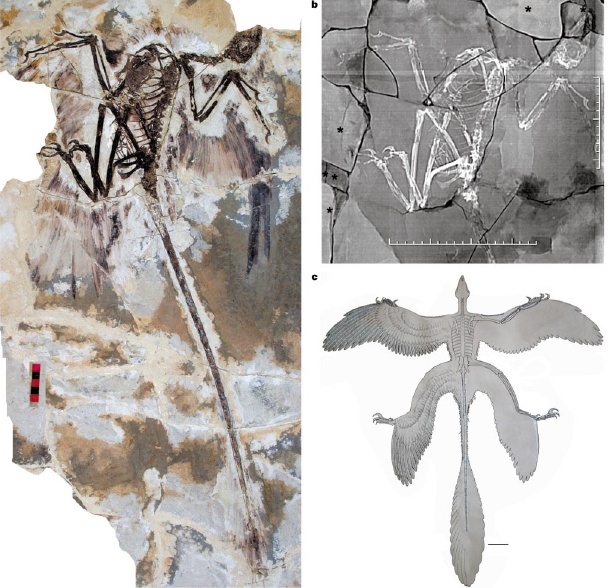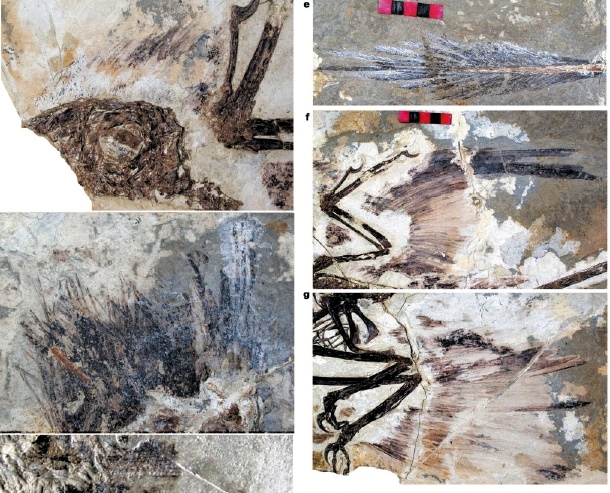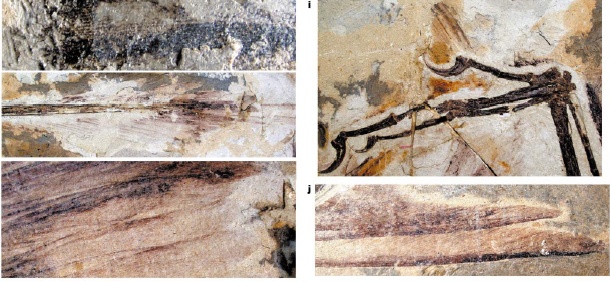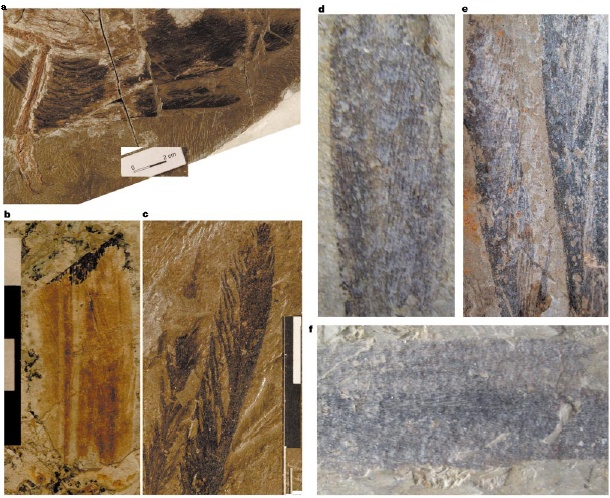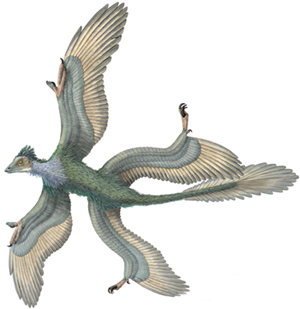|
|
|
||||||||||||||||||||||||||||||||||||||||||||||||||||||||||
|
简介(Brief Introduction) |
||
|
[A]中国科学院古脊椎动物与古人类研究所徐星博士和他的同事在《自然》杂志上报告说,在中国辽宁发掘出的这六具恐龙化石有着与众不同的特征,它的前肢与后肢都长出了羽毛。科学家还是第一次遇到拥有这种特征的化石。这种恐龙被命名为顾氏小盗龙(Microraptor gui),这个名称是献给中科院院士、古生物学家顾知微。 顾氏小盗龙生活在距今大约1.3亿年之前的早白垩纪,它身长不到1米,四肢和尾巴都覆盖着羽毛,科学家推测,它们利用四肢覆盖的羽毛,可以从一棵树飞行到另外一棵树——这有点类似于今天鼯鼠的“飞行”方式。 鸟类是如何进化而来这一问题一直是生物学家争论的话题。目前,大多数生物学家都认为,鸟类是由恐龙进化而来,迄今发现与鸟类关系最近的恐龙是兽脚类恐龙和奔龙。然而,生物学家还面临着一个更棘手的问题:鸟类是如何进化出飞行的能力的?有两种互不相让的假说,一种是“树栖假说”,即鸟类的祖先栖息在树上,借助于羽毛,它们能从树上“滑翔”下来,逐渐进化出了主动飞行的能力。另外一种是“地栖假说”,这一理论认为鸟类的祖先生活在地上,它们肢体上的羽毛有助于行动,帮助捕食或者逃避捕食者。经历了一个高速奔跑的阶段之后,它们终于飞上了天空。 很难想象一个拥有四只翅膀的恐龙如何在奔跑的时候同时拍动四只翅膀,徐星等人认为,顾氏小盗龙的发现为“树栖假说”——这一假说的化石证据相对较少——提供了支持的证据,即顾氏小盗龙生活在树上,通过滑翔逐渐进化出了飞行的能力。 80多年以前,生物学家William Beebe提出了一种假说,认为鸟类进化包括了一个四翼阶段,但是直到顾氏小盗龙发现之前,还没有任何化石证据。 毫无疑问,顾氏小盗龙的发现是非常振奋的,我国科学工作者再攀新峰!然,根据国外专家评论(不代表本站观点),顾氏小盗龙的后肢羽毛是长在胫骨Tibia一侧,这表明顾氏小盗龙的‘后翼’不可能‘拍打’,最多是滑翔。 |
||
|
化石写真(Fossil Pic.) |
||
|
|
||
|
Figure 1 Microraptor gui.
|
||
|
||
|
Figure 2 Feathers of IVPP V13352 and TNP00996. Feathers attached to the skull (a), the tail (d), the forelimb (f), the manual digit I (i), and the hindlimb (g) of IVPP V13352, and to the skull (b) and the tail (e) of TNP00996; close-up of the skull feathers of TNP 00996 (c), and of secondaries (h) and large pennaceous feathers on distal metatarsus (j) of IVPP V13352. Note the pennaceous feathers attached to the digit (i) that might be a precursor to the alula. This is concordant with the fact that M. gui has a short manual digit I, because the alula is often associated with a reduced alular digit except in Protopteryx 24. Scale bar, 5 cm. |
||
|
|
||
|
Figure 3 Feathers showing the asymmetrical vanes. Pennaceous feathers attached to the
left metatarsus of IVPP V13477 (a) and right metatarsus of IVPP V13320 (b). c, Close-up
of a distal pennaceous feather on the left metatarsus of IVPP V13477. d, Close-up of a |
||
|
复原图(Restitute Pic.) |
||
|
|
||
|
本站复原图(保留版权)(Copyrighted Restitute Pic.) |
||
|
|

